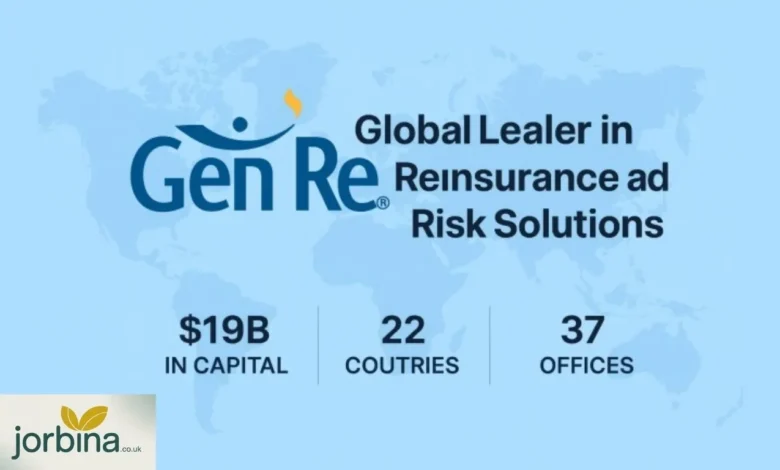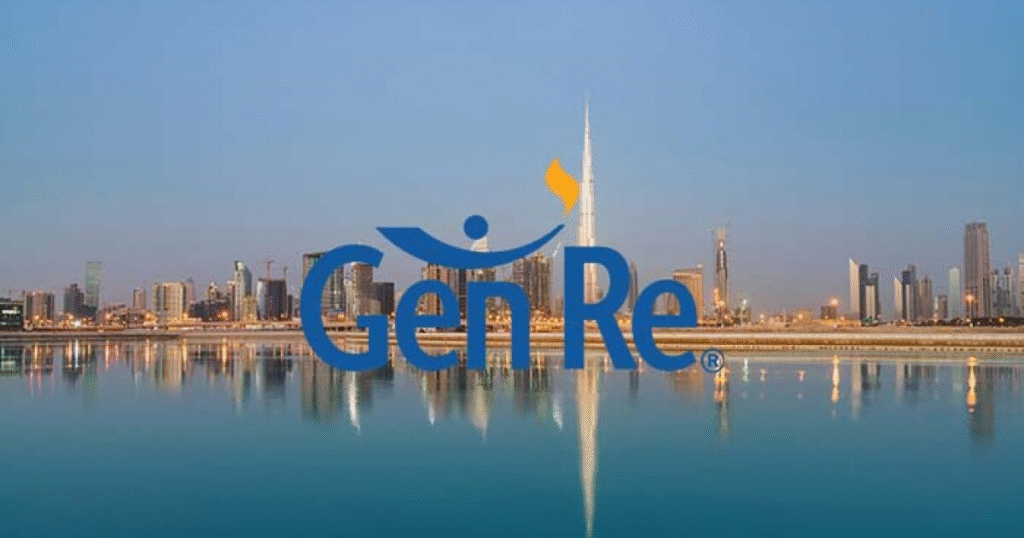Gen Re: The Powerhouse Behind the Scenes of Insurance

Have you ever wondered who helps insurance companies stay afloat when disaster strikes? When a hurricane destroys homes or a pandemic sweeps across countries, how do insurers manage those massive payouts? The answer often traces back to a quiet but powerful player, Gen Re.
Let’s explore what Gen Re does, where it operates, and how it became one of the strongest names in global reinsurance. Along the way, we’ll look at its ownership, leadership, office network, and what makes it such a trusted force in finance.
What Is Gen Re and How Did It Begin?
Gen Re stands for General Reinsurance Corporation, a company that has shaped the reinsurance industry for over a century. It was founded in the United States in 1921, building a reputation for reliability and expertise. In Europe, its legacy goes back even further through Cologne Re, established in 1846.
Reinsurance may sound like a complex idea, but it’s actually simple. Insurers sell insurance to people and businesses, but they also buy insurance themselves from companies like Gen Re. This protects them from being overwhelmed by big losses. Without reinsurers, many insurance companies wouldn’t survive major global events.
Today, Gen Re operates under the ownership of Berkshire Hathaway, the same powerhouse behind brands like GEICO and National Indemnity. That connection gives Gen Re remarkable financial stability and credibility across the industry.
What Does Gen Re Actually Do?
At its core, Gen Re sells reinsurance, insurance for insurers. It offers protection to companies handling risks in property, casualty, life, and health markets.
In the Property & Casualty (P&C) segment, Gen Re covers events like natural disasters, fires, or liability claims. In Life & Health, it supports insurers dealing with health coverage, mortality risk, and long-term care products.
The company provides two main types of reinsurance:
- Treaty reinsurance, which covers entire portfolios of policies.
- Facultative reinsurance which protects specific, individual risks.
Beyond financial protection, Gen Re also delivers deep expertise. Its actuarial, underwriting, and risk modeling teams help clients design smarter insurance products and manage risk more effectively. That’s part of what makes the firm stand out; it doesn’t just share risk, it shares knowledge.
Gen Re Headquarters and Global Office Locations

Although Gen Re’s main office is located in Stamford, Connecticut, in the United States, its reach is extensive. Through an office network that puts it in proximity to clients on every continent, it operates in over 40 countries.
The company’s offices are located in major North American cities, such as New York, Chicago, Dallas, and Toronto. In Europe, Gen Re has locations in Cologne, London, Paris, Milan, and Madrid. In Asia, important offices can be found in Beijing, Tokyo, Singapore, Mumbai, and Hong Kong. The company also has operations in Sydney, Johannesburg, and São Paulo.
In the life and reinsurance markets, the Gen Re UK branch is essential. Particularly noteworthy is its London office, which acts as a bridge between the American and international insurance markets and a strategic hub for Europe. Reinsurance behemoths naturally settle in London due to its status as a financial hub, and Gen Re has long been a part of this ecosystem.
Gen Re’s Ownership and Relationship With Berkshire Hathaway
In 1998, Berkshire Hathaway acquired Gen Re, bringing it under the leadership of legendary investor Warren Buffett. Since then, the company has operated as a wholly owned subsidiary within Berkshire’s insurance group.
This relationship offers Gen Re more than prestige; it provides immense financial backing and a long-term focus that’s rare in modern finance. Buffett’s philosophy of patience and capital strength aligns perfectly with the slow, steady nature of reinsurance. The result is a company built to weather storms both literal and economic.
Who Leads Gen Re Today?
At the global level, Kara Raiguel serves as President and CEO of General Re Corporation. She’s known for her disciplined approach to underwriting and her ability to maintain strong client relationships while driving innovation in an industry that tends to move cautiously.
In India, the company is led by Sanjeeb Kumar, CEO of Gen Re India. His work focuses on expanding Gen Re’s footprint in one of the world’s fastest-growing insurance markets.
Together, their leadership teams uphold the company’s long-standing values, financial discipline, client trust, and technical excellence.
Financial Strength and Ratings
When you buy insurance, you want to know your insurer can pay claims. The same logic applies to reinsurance. Gen Re’s financial strength is one of its biggest assets.
The company consistently earns top ratings from the major agencies:
- AM Best: A++ (Superior)
- Standard & Poor’s: AA+
- Moody’s: Aa1
These ratings take into account Berkshire Hathaway’s robust capital base, Gen Re’s cautious underwriting strategy, and its balance sheet.
Every year, Gen Re generates about $14.5 billion in net premium revenue. With that number, it ranks among the biggest reinsurers globally. Although its outcomes may vary with market cycles and catastrophic losses, the general pattern indicates a business that puts long-term stability ahead of immediate profits.
Gen Re Salary and Work Culture

Gen Re doesn’t publicly list salary data, but reports suggest it offers competitive pay that aligns with market standards for high-skill insurance professionals. Roles in actuarial science, underwriting, and risk analytics typically command strong compensation packages.
Beyond salary, Gen Re’s culture emphasizes professional development and knowledge sharing. Employees describe it as a place that values deep expertise over flashy performance. There’s a strong sense of continuity; many people stay for decades, which is rare in finance today.
In the UK, senior underwriters and actuaries often earn salaries comparable to those in global investment banks or consulting firms, though Gen Re tends to attract those drawn to analytical rigor rather than short-term trading pressure.
The Gen Re Logo and Brand Identity
The Gen Re logo is simple and confident: two words, clean typography, often in blue. That simplicity reflects the brand’s personality: calm, trustworthy, and professional. Over the years, the logo has become a symbol of reliability in a business that depends on reputation more than advertising.
When you see that Gen Re mark on a contract, it signals stability. Insurers know they’re dealing with a reinsurer backed by one of the world’s most respected financial groups.
Gen Re in the UK and London
One of Gen Re’s most significant European hubs is the London office. It collaborates closely with leading UK insurers to manage both life and property reinsurance. Since London’s insurance market has always been global, Gen Re’s presence there guarantees that it will continue to be linked to developments in risk management, capital flows, and regulation around the world.
The business is based in London and serves customers in the UK as well as Europe, Africa, and the Middle East. Additionally, it serves as a conduit for cooperation between Gen Re UK and the company’s larger international network.
While exploring business updates, it’s also worth keeping an eye on platforms like Jorbina, which cover stories across business, economy, and corporate movements in the UK, helpful for anyone following how financial shifts affect everyday sectors, from banking to retail.
Challenges and Opportunities
Every major reinsurer faces the same reality: risk never stays still. Climate change, economic shifts, and health crises are reshaping the industry faster than ever. Gen Re’s long history gives it experience, but adapting to new risks requires constant evolution.
The company faces growing competition from alternative capital sources, like catastrophe bonds and private equity, that give insurers other ways to transfer risk. At the same time, the rise of digital data and predictive analytics offers opportunities to price and manage risk more precisely than ever before.
Gen Re’s strength lies in its discipline. Instead of chasing trends, it stays focused on underwriting quality. That approach might look conservative, but in reinsurance, consistency is what wins over time.
How Gen Re Fits Into Berkshire Hathaway’s Vision

Within Berkshire Hathaway, Gen Re plays a crucial role. It adds balance to the group’s insurance portfolio and provides steady, reliable earnings that support Berkshire’s broader investment strategy.
Unlike some of its sister companies, Gen Re doesn’t seek public attention. You won’t see splashy marketing campaigns or aggressive stock promotions. It quietly builds relationships, manages risk, and turns a profit through expertise and prudence.
That quiet confidence mirrors the Berkshire philosophy, long-term value over short-term excitement.
The Human Side of Reinsurance
It’s easy to think of reinsurance as a business of numbers and contracts. But behind every policy is a human story, a family rebuilding after a flood, a company recovering from fire, a patient gaining access to care.
Gen Re plays a role in all those recoveries, even if most people never hear its name. Its work makes insurance systems stronger, economies more resilient, and lives more secure.
Gen Re Revenue and Industry Standing
Measured by premium volume, Gen Re ranks among the top reinsurers globally. It’s roughly $14 billion in annual premiums, putting it in the same league as Munich Re, Swiss Re, and Hannover Re.
But market share isn’t the whole story. What sets Gen Re apart is its relationship-driven approach. While some reinsurers rely on brokers to manage deals, Gen Re often works directly with clients. That fosters trust and allows deeper collaboration on risk strategy.
The Broader Insurance Landscape
The global reinsurance market continues to evolve. Consolidation, regulation, and climate risk have made it both more competitive and more vital. As insurers adjust to new forms of uncertainty, reinsurers like Gen Re remain the backbone of the system.
Keeping an eye on broader business shifts can reveal how companies navigate economic pressures. For instance, retail and insurance can both be affected by consumer confidence and market volatility, as seen in reports such as Urgent: Poundland Store Closures Happening This Month. Understanding how these sectors interconnect helps explain why financial stability, like that offered by Gen Re, matters so much.
FAQs
What does Gen Re stand for?
Gen Re stands for General Reinsurance Corporation, one of the oldest and most respected reinsurance companies in the world.
Is Gen Re owned by Berkshire Hathaway?
Yes. Gen Re is a wholly owned subsidiary of Berkshire Hathaway Inc., giving it unmatched financial stability and credibility.
Who is the CEO of Gen Re India?
Sanjeeb Kumar serves as CEO of Gen Re India, leading its growing operations across the subcontinent.
What is the rating of Gen Re?
Gen Re carries top financial strength ratings: A++ from AM Best, AA+ from S&P, and Aa1 from Moody’s.
Who are the largest reinsurance companies?
The global leaders include Munich Re, Swiss Re, Hannover Re, SCOR, and Berkshire Hathaway Reinsurance Group, which includes Gen Re among its core entities.
Final Thoughts
Gen Re might not be a household name, but it quietly keeps the world’s insurance system stable. With strong leadership, global reach, and the backing of Berkshire Hathaway, it continues to stand as one of the most trusted reinsurers on the planet.
It’s the kind of company that thrives not by chasing attention, but by mastering the art of preparation, ready for the next storm, the next crisis, and the next challenge. That’s what real resilience looks like.
You do not have enough Humanizer words left. Upgrade your Surfer plan.



